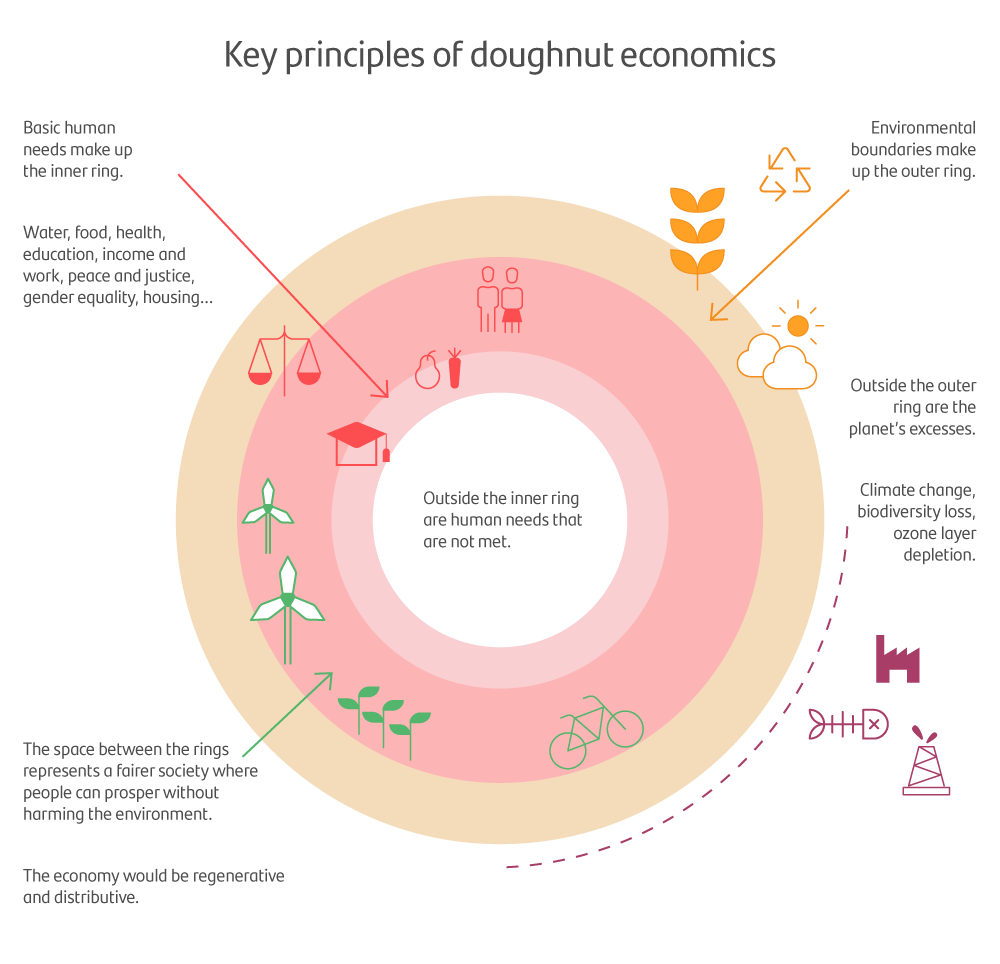Doughnut economics: Balancing the well-being of people and the planet


Sustainable growth hinges on meeting both humans’ and the environment’s needs. Several cities have adopted a new economic development model to address the climate crisis. Here we tell you what it is and how you can form part of it.
According to the United Nations, the world’s population could rise from 8 billion to 9.7 billion by 2050. Because natural resources are finite, one of the biggest challenges of population growth is meeting humans’ basic needs without breaching the environment's limits. A few years ago, British economist and lecturer at Oxford and Cambridge Universities Kate Raworth came up with an alternative growth model. Her economic development theory seeks to promote progress without further harming the environment. She calls it “doughnut economics”.
Raworth posits an economy that goes beyond industry growth and profitability. She bases her theory on the idea of guaranteeing food, education, health, housing, water, energy and work, as well as other basic needs of people in what she collectively terms the “social foundation”. For her model to be sustainable in the future, we must not break the environmental boundaries that she calls the “ecological ceiling”. Those boundaries include climate change, ocean acidification, ozone layer depletion and biodiversity loss.
Amsterdam, a doughnut economics trailblazer
London, Philadelphia, Berlin, Barcelona and other cities are working on implementing doughnut economics. However, Amsterdam is ahead of the pack. Halving the use of new raw materials by 2030 and having a fully circular economy by 2050 are just some of its aims. Its initiatives include setting up physical stores and apps to buy, sell, exchange and repair second-hand goods. That way, locals will have access to cheaper electronics, clothes, furniture and other products that are still in good condition.
What is “doughnut economics”?
Raworth uses the roundness of a doughnut to illustrate her economic model. The inner ring of the doughnut represents society’s basic needs (the “social foundation”) at the centre of the economy. The outer ring represents the planet’s ecological ceiling, or environmental limits. In between the two rings — the dough — lies a regenerative and distributive economy that can help society and the planet thrive.
Below the social foundation, people would be unable to meets their basic needs. Breaking the ecological ceiling would lead to the depletion of natural resources.

Doughnut economics and personal finances
Traditional linear production turns natural resources into things that we use for a certain time before discarding them and manufacturing new ones from more natural resources. Doughnut economics suggests replacing that cycle with the circular economy, collaborative economy, blue economy and other development models that prioritize reusing consumables and using waste as a raw material.
To help society prosper, protect the planet and keep our finances healthy, you can:
If the stock market is your thing, why not trade securities that follow environmental, social and governance (ESG) standards? For instance, green bonds offer profitability on top of a positive impact on people and the planet.
Ensuring access to basic services for everyone is one of the aims of doughnut economics. Bridging the digital gap and harnessing new technologies like blockchain, the Internet of Things, the Banking of Things (BoT) and artificial intelligence (AI) can make using digital banking, online training and other creature comforts easier.
We must optimize our use of the planet’s resources to meet our needs without overstepping environmental boundaries. Reusing, repairing or recycling your electronics or their components; buying and selling second-hand goods at a lower price; and not wasting food, water and power are just some of the ways you can help. Check out these 10 ways to save water (in Spanish) on Santander Consumer España’s blog, Tu Futuro Próximo (“Your near future”).
Linear economic growth has been governments’ go-to model for years. However, the planet is not able to regenerate at the same rate as natural resource use. Doughnut economics embodies the importance of understanding and respecting the limits of the planet’s resources so people and the environment can pull in the same direction.







